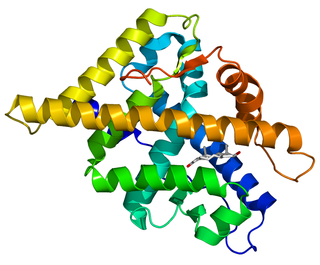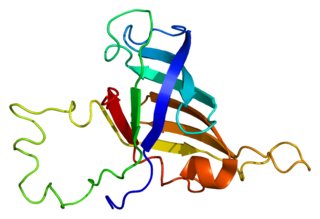RISC-loading complex subunit TARBP2 is a protein that in humans is encoded by the TARBP2 gene. [5] [6]
RISC-loading complex subunit TARBP2 is a protein that in humans is encoded by the TARBP2 gene. [5] [6]
HIV-1, the causative agent of acquired immunodeficiency syndrome (AIDS), contains an RNA genome that produces a chromosomally integrated DNA during the replicative cycle. Activation of HIV-1 gene expression by the transactivator Tat is dependent on an RNA regulatory element (TAR) located downstream of the transcription initiation site. The protein encoded by this gene binds between the bulge and the loop of the HIV-1 TAR RNA regulatory element and activates HIV-1 gene expression in synergy with the viral Tat protein. Alternative splicing results in multiple transcript variants encoding different isoforms. This gene also has a pseudogene. [6]
TARBP2 has been shown to interact with Protein kinase R [7] [8] and RBM14. [9]

The androgen receptor (AR), also known as NR3C4, is a type of nuclear receptor that is activated by binding any of the androgenic hormones, including testosterone and dihydrotestosterone in the cytoplasm and then translocating into the nucleus. The androgen receptor is most closely related to the progesterone receptor, and progestins in higher dosages can block the androgen receptor.

Protein kinase RNA-activated also known as protein kinase R (PKR), interferon-induced, double-stranded RNA-activated protein kinase, or eukaryotic translation initiation factor 2-alpha kinase 2 (EIF2AK2) is an enzyme that in humans is encoded by the EIF2AK2 gene.

Transcription factor Jun is a protein that in humans is encoded by the JUN gene. c-Jun, in combination with protein c-Fos, forms the AP-1 early response transcription factor. It was first identified as the Fos-binding protein p39 and only later rediscovered as the product of the JUN gene. c-jun was the first oncogenic transcription factor discovered. The proto-oncogene c-Jun is the cellular homolog of the viral oncoprotein v-jun. The viral homolog v-jun was discovered in avian sarcoma virus 17 and was named for ju-nana, the Japanese word for 17. The human JUN encodes a protein that is highly similar to the viral protein, which interacts directly with specific target DNA sequences to regulate gene expression. This gene is intronless and is mapped to 1p32-p31, a chromosomal region involved in both translocations and deletions in human malignancies.

Cyclin-dependent kinase 9 or CDK9 is a cyclin-dependent kinase associated with P-TEFb.

Transcription factor p65 also known as nuclear factor NF-kappa-B p65 subunit is a protein that in humans is encoded by the RELA gene.

Cyclin-T1 is a protein that in humans is encoded by the CCNT1 gene.

DNA-directed RNA polymerase II subunit RPB3 is an enzyme that in humans is encoded by the POLR2C gene.

DNA-directed RNA polymerases I, II, and III subunit RPABC1 is a protein that in humans is encoded by the POLR2E gene.

DNA-directed RNA polymerase II subunit RPB2 is an enzyme that in humans is encoded by the POLR2B gene.

DNA-directed RNA polymerases I, II, and III subunit RPABC3 is a protein that in humans is encoded by the POLR2H gene.

DNA-directed RNA polymerases I, II, and III subunit RPABC2 is a protein that in humans is encoded by the POLR2F gene.

DNA-directed RNA polymerases I, II, and III subunit RPABC5 is a protein that in humans is encoded by the POLR2L gene.

DNA-directed RNA polymerase II subunit RPB11-a is an enzyme that in humans is encoded by the POLR2J gene.

DNA-directed RNA polymerase II subunit RPB4 is an enzyme that in humans is encoded by the POLR2D gene.

DNA-directed RNA polymerase II subunit RPB9 is an enzyme that in humans is encoded by the POLR2I gene.

Interleukin enhancer-binding factor 3 is a protein that in humans is encoded by the ILF3 gene.

Cyclin-H is a protein that in humans is encoded by the CCNH gene.

Cyclin-K is a protein that in humans is encoded by the CCNK gene.

Probable methyltransferase TARBP1 is an enzyme that in humans is encoded by the TARBP1 gene.

In molecular biology, Tat is a protein that is encoded for by the tat gene in HIV-1. Tat is a regulatory protein that drastically enhances the efficiency of viral transcription. Tat stands for "Trans-Activator of Transcription". The protein consists of between 86 and 101 amino acids depending on the subtype. Tat vastly increases the level of transcription of the HIV dsDNA. Before Tat is present, a small number of RNA transcripts will be made, which allow the Tat protein to be produced. Tat then binds to cellular factors and mediates their phosphorylation, resulting in increased transcription of all HIV genes, providing a positive feedback cycle. This in turn allows HIV to have an explosive response once a threshold amount of Tat is produced, a useful tool for defeating the body's response.